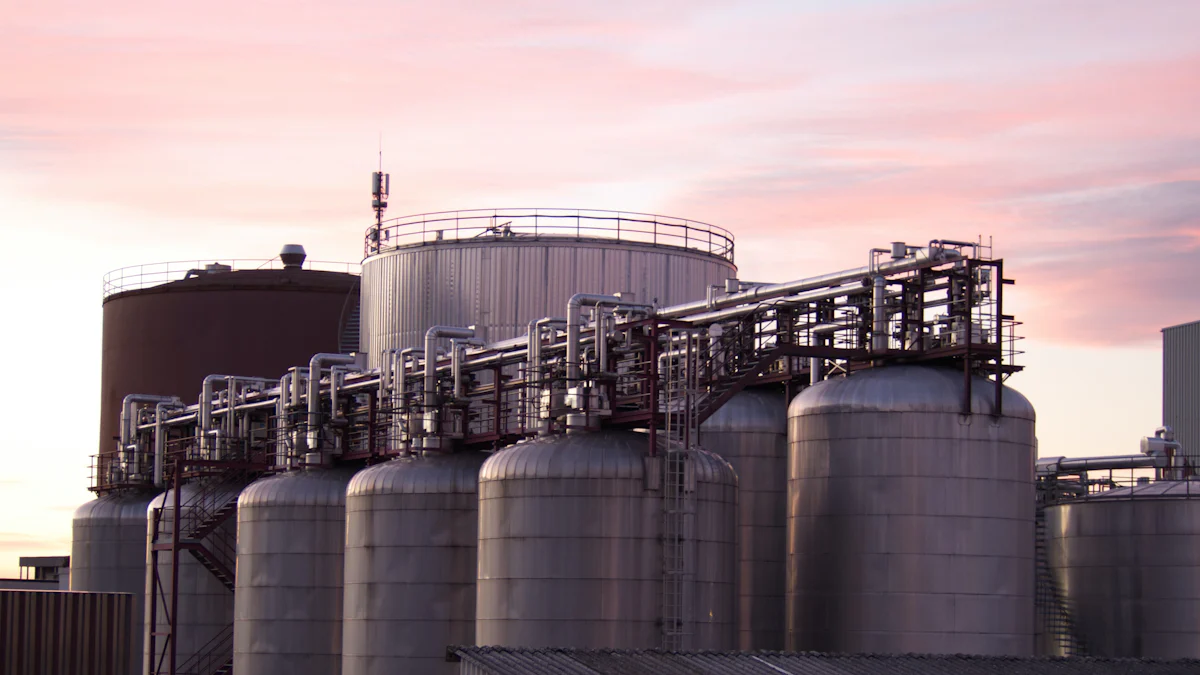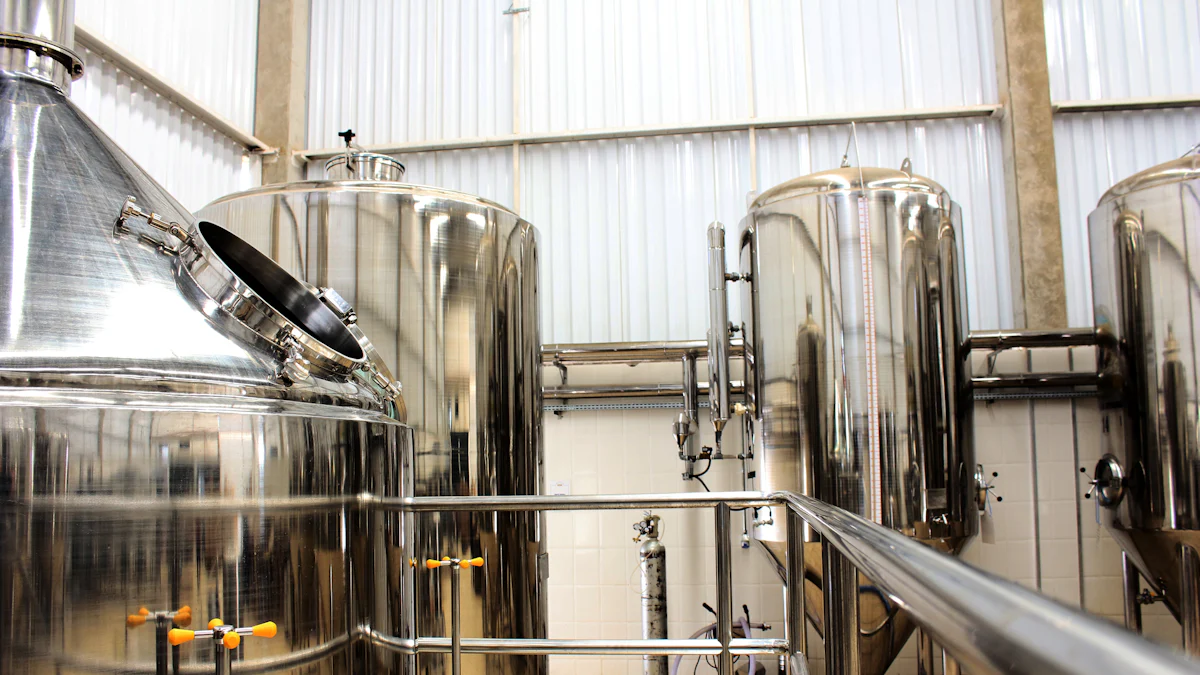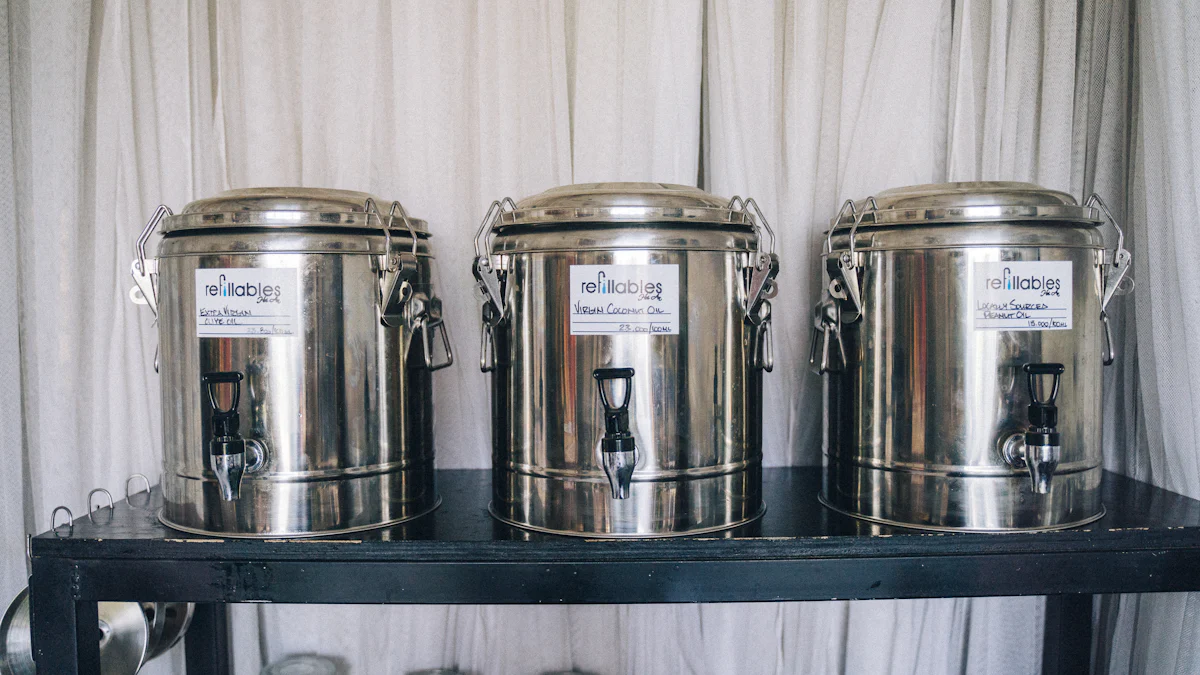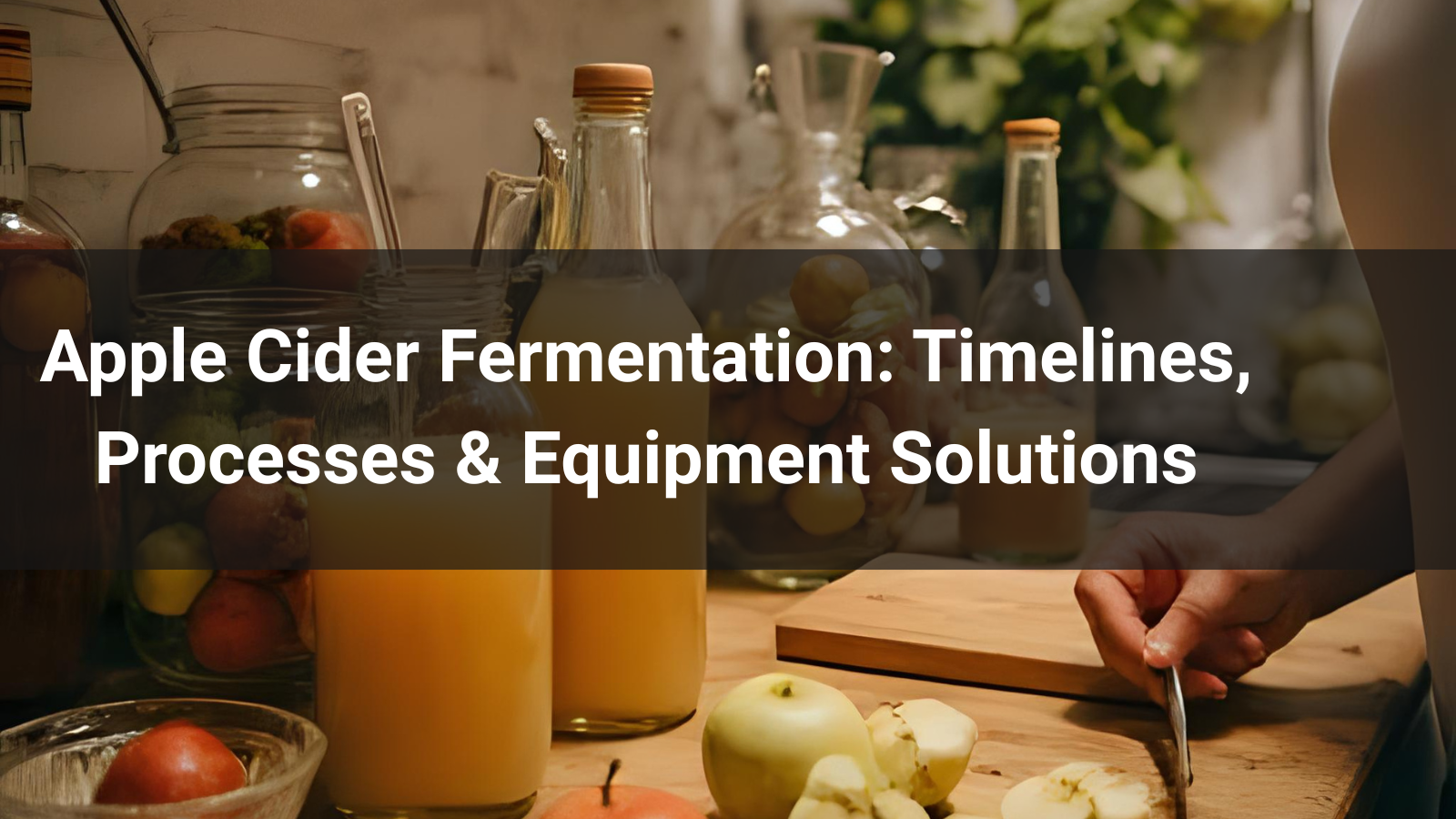
When it comes to preserving the rich flavor and freshness of olive oil, the right storage solution makes all the difference. An olive oil stainless steel tank offers unmatched protection, keeping your oil safe from harmful elements like oxygen, light, and moisture. These tanks prevent oxidation by using inert gas fittings, which shield the oil from turning rancid. Their non-reactive surface ensures no unwanted flavors or odors seep into your oil, while conical bottoms make it easy to remove sediment and impurities. With proper care, these tanks maintain the quality of your olive oil, so every drop stays as pure as the day it was made.
Why Choose an Olive Oil Stainless Steel Tank?
When it comes to storing olive oil, not all containers are created equal. Choosing an olive oil stainless steel tank offers several advantages that ensure your oil stays fresh, flavorful, and safe for longer periods. Let’s explore why these tanks are the best choice for your olive oil storage needs.
Durability and Longevity
Stainless steel tanks are built to last. Their robust construction resists dents, scratches, and corrosion, even in demanding environments. Unlike plastic or glass, stainless steel doesn’t degrade over time. This means you won’t have to worry about replacing your tank frequently. Investing in a stainless steel tank saves you money in the long run while providing reliable storage for years to come.
Hygienic and Non-Reactive Properties
One of the biggest benefits of stainless steel is its non-reactive surface. This material doesn’t interact with olive oil, so the oil retains its original taste and aroma. Other materials, like plastic, can leach chemicals or odors into the oil, compromising its quality. Stainless steel also prevents moisture and sunlight from penetrating, which helps maintain a stable environment inside the tank.
Additionally, these tanks are incredibly easy to clean. Their smooth surfaces don’t trap residue, making it simple to remove impurities. Conical bottoms further aid in sediment removal, ensuring your olive oil remains pure and uncontaminated.
- Prevents unwanted flavors or odors from affecting the oil.
- Blocks moisture and sunlight, reducing the risk of oxidation.
- Equipped with inert gas fittings to displace oxygen and prevent rancidity.
Protection Against Light, Oxygen, and Temperature Fluctuations
Olive oil is sensitive to environmental factors like light, air, and temperature changes. Stainless steel tanks are designed to shield your oil from these threats. They block harmful UV rays and create an airtight seal to keep oxygen out. Many tanks also include inert gas fittings, which replace oxygen with nitrogen or argon. This prevents oxidation, preserving the oil’s flavor and nutritional value.
Temperature stability is another key feature. Stainless steel’s insulating properties help maintain a consistent temperature, even in fluctuating conditions. This is crucial for extending the shelf life of your olive oil and ensuring it stays as fresh as possible.
By choosing a stainless steel tank, you’re giving your olive oil the best possible protection. It’s a smart investment that pays off in quality and peace of mind.
Cost-Effectiveness Over Time
When you invest in an olive oil stainless steel tank, you’re not just buying a storage container—you’re making a smart financial decision. These tanks might seem like a significant upfront expense, but their long-term benefits far outweigh the initial cost. Let’s break down why they’re a cost-effective choice for olive oil storage.
First, stainless steel tanks are built to last. Their durable construction resists wear and tear, meaning you won’t need to replace them frequently. Unlike plastic or glass containers, which can degrade or break over time, stainless steel remains reliable for years. This durability saves you money on replacements and repairs.
Another major advantage is the way these tanks preserve the quality of your olive oil. By providing a safe, hygienic, and controlled environment, they help maintain the oil’s integrity. This means less spoilage and fewer losses. For producers, this can translate into significant savings. You won’t have to worry about the costs associated with degraded or rancid oil. Instead, you can focus on delivering a product that meets the highest standards of quality production.
Stainless steel tanks also reduce operational costs. Their smooth surfaces make cleaning quick and easy, saving you time and effort. Plus, their non-reactive properties mean you don’t need to spend extra on specialized cleaning agents. Over time, these small savings add up, making stainless steel tanks a practical and economical choice.
In the long run, these tanks pay for themselves. They protect your olive oil, streamline your processes, and minimize waste. Whether you’re a small-scale producer or a large distributor, investing in a stainless steel tank is a decision that benefits both your wallet and your product.
Best Practices for Cleaning Olive Oil Stainless Steel Tanks
Keeping your olive oil stainless steel tank clean is essential for maintaining the quality and freshness of your oil. Proper cleaning not only prevents contamination but also ensures your tank lasts longer. Let’s dive into the best practices for cleaning these tanks effectively.
Recommended Cleaning Frequency
How often should you clean your tank? Regular cleaning is key. If you’re using the tank daily, clean it after every use. For less frequent use, a thorough cleaning every few weeks or after each batch of oil is ideal. This prevents residue buildup, which can compromise the oil’s quality. Sticking to a consistent cleaning schedule ensures your tank stays in top condition.
Food-Safe Cleaning Agents and Methods
Choosing the right cleaning agents and methods is crucial. Not all cleaners are safe for stainless steel tanks, especially those used for food storage. Here’s what you should know:
Avoiding Abrasive Materials
Avoid abrasive pads or brushes when cleaning your tank. These can scratch the surface, creating tiny crevices where bacteria can hide. Instead, use soft cloths or non-abrasive brushes. For stubborn residues, let the tank soak with a pH-neutral cleaner before scrubbing gently. This approach protects the tank’s smooth surface while effectively removing grime.
Proper Rinsing and Drying Techniques
Rinsing thoroughly is just as important as cleaning. Make sure to wash away all cleaning agents with clean, potable water. Any leftover residue can lead to contamination or corrosion. After rinsing, dry the tank completely. Water spots or moisture can damage the tank over time. Use a clean, dry cloth to wipe it down or let it air dry in a clean environment.
Sanitization to Prevent Contamination
Sanitizing your tank is the final step to ensure it’s safe for storing olive oil. Follow these steps for effective sanitization:
- Use food-grade sanitizers designed for stainless steel tanks.
- Apply the sanitizer evenly and follow the manufacturer’s instructions.
- Rinse thoroughly with clean water to remove any sanitizer residue.
- Dry the tank completely to prevent water spots or corrosion.
- For added protection, consider heat sterilization if your tank allows it.
By following these practices, you’ll keep your tank clean and your olive oil free from contamination. A clean tank means better quality oil and peace of mind for you.
Optimal Storage Conditions for Olive Oil

Storing olive oil properly is essential to maintain its freshness, flavor, and shelf-life. By following a few key guidelines, you can ensure your olive oil stays as fresh as the day it was bottled.
Maintaining the Ideal Temperature Range
Temperature plays a huge role in preserving olive oil quality. Keeping your oil within the optimal storage temperature range prevents it from spoiling or losing its flavor.
- The ideal temperature for olive oil storage is around 57°F.
- If maintaining this isn’t possible, a normal room temperature of 70°F works well, provided the oil is kept in a dark area.
- Avoid storing your oil near heat sources like stoves or radiators, as temperatures above 75°F can accelerate degradation.
By maintaining a stable temperature, you’ll protect your olive oil from unnecessary chemical changes that could shorten its shelf-life.
Minimizing Light Exposure
Light exposure is another factor that can harm your olive oil. When olive oil is exposed to light, especially UV rays, it undergoes chemical reactions that lead to oxidation. This process not only affects the oil’s flavor but also reduces its nutritional value.
To minimize light exposure:
- Store your olive oil in a dark cupboard or pantry.
- If you’re using a transparent container, consider switching to tinted glass or stainless steel tanks. These materials block harmful light and help preserve the oil’s quality.
Keeping your oil away from direct sunlight or even diffused light will go a long way in maintaining its freshness.
Controlling Oxygen Levels
Exposure to air is one of the biggest threats to olive oil. Oxygen triggers oxidation, which can make your oil rancid over time. Thankfully, there are effective ways to control oxygen levels in your storage tanks.
Importance of Tightly Sealed Tanks
Always ensure your olive oil stainless steel tank is tightly sealed. A proper seal prevents air from entering the tank and coming into contact with the oil. This simple step can significantly extend the shelf-life of your oil.
Using Nitrogen or Argon for Inert Atmosphere
For even better protection, consider using inert gases like nitrogen or argon. These gases displace oxygen inside the tank, creating an environment where oxidation can’t occur. Many tanks come equipped with valves that connect to nitrogen bottles, making it easy to maintain an inert atmosphere. This method is especially useful for long-term storage or when you want to preserve fresh oil for extended periods.
By controlling oxygen levels, you’re taking a proactive step toward ensuring your olive oil remains flavorful and high-quality.
Preventing Contamination in Olive Oil Stainless Steel Tanks
Keeping your olive oil free from contamination is crucial for maintaining its quality and flavor. By following a few simple practices, you can ensure your stainless steel tank remains a safe and hygienic storage solution.
Regular Inspection for Residue or Impurities
You should inspect your tank regularly to catch any residue or impurities before they become a problem. Even small amounts of leftover oil or sediment can lead to contamination over time. Look for signs of buildup, discoloration, or unusual odors. These could indicate that your tank needs cleaning or sanitizing. A quick visual check after each use and a more thorough inspection every few weeks will help you stay ahead of potential issues.
Avoiding Cross-Contamination with Other Substances
Cross-contamination can ruin your olive oil’s quality. It happens when your oil comes into contact with other substances, like cleaning agents, leftover residues, or even air. Here’s how you can avoid it:
- Use dedicated tanks for olive oil storage. Don’t mix oils or other liquids in the same tank.
- Limit exposure to air and light, as these can cause oxidative deterioration and lipid oxidation.
- Store your tank in a clean, temperature-controlled environment to prevent external contamination.
- Employ laminar filtration methods to reduce air exposure during storage.
By taking these precautions, you’ll protect your olive oil from unwanted chemical reactions and preserve its natural flavor.
Proper Handling During Transfers
Transferring olive oil between containers or tanks can be tricky. If you’re not careful, you might introduce air or impurities that affect the oil’s quality. Follow these best practices to handle transfers safely:
- Avoid prolonged exposure to air during the process.
- Use pumps or spouts designed to minimize splashing, which can introduce air and accelerate oxidation.
- For bulk storage, consider closed-system pumps. These systems reduce the risk of contamination by keeping the oil sealed off from external elements.
Taking your time and using the right tools will ensure your olive oil stays fresh and uncontaminated during transfers.
Tip: Always clean and sanitize your equipment before transferring oil. This extra step can make a big difference in maintaining quality.
By staying vigilant and following these steps, you’ll keep your olive oil safe from contamination and ensure it remains as pure as possible.
Common Mistakes to Avoid with Olive Oil Stainless Steel Tanks
Even with the best stainless steel tanks, a few common mistakes can compromise the quality of your olive oil. Avoiding these pitfalls will help you maintain the oil’s freshness and ensure your tank lasts for years.
Overcrowding Tanks
Packing your tank to the brim might seem efficient, but it can lead to problems. Overcrowding leaves little room for proper air circulation, which can cause uneven storage conditions. This increases the risk of contamination and affects the oil’s quality. Always leave some space at the top of the tank. This allows you to use inert gases like nitrogen or argon to displace oxygen, protecting the oil from oxidation. A little extra room goes a long way in preserving your olive oil’s flavor and nutritional value.
Using Improper Seals or Lids
The seal on your tank is more important than you might think. Improper seals or lids can let air seep into the tank, exposing your olive oil to oxygen. This exposure accelerates oxidation, which leads to rancidity. Rancid oil not only loses its flavor but also its nutritional benefits. To avoid this, always check that your tank’s lid fits tightly. If your tank supports it, use a vacuum-sealed or airtight lid for added protection. A proper seal keeps your oil safe and ensures it stays fresh for longer.
Neglecting Regular Maintenance
Skipping maintenance is one of the biggest mistakes you can make. Regular upkeep keeps your tank in top condition and prevents long-term damage. Here’s what you should focus on:
- Clean your tank regularly with mild detergents to remove contaminants.
- Avoid harsh chemicals that could damage the tank’s surface.
- Inspect the tank for cracks, corrosion, or wear. Addressing these issues early prevents serious problems later.
Additionally, lubricate any moving parts and control the environment around your tank to minimize condensation. Protective treatments like passivation can also restore the tank’s corrosion resistance. By staying on top of maintenance, you’ll extend the life of your tank and keep your olive oil free from contamination.
Tip: Set a maintenance schedule to make sure you don’t miss these essential tasks. A little effort now saves you from bigger headaches down the road.
Storing Tanks in Inappropriate Environments
Where you store your olive oil stainless steel tank matters more than you might think. The wrong environment can damage the tank and ruin the quality of your olive oil. Let’s look at what to avoid and how to create the perfect storage space.
Avoid Extreme Temperatures
Extreme heat or cold can wreak havoc on your tank and its contents. High temperatures can cause the oil to degrade faster, losing its flavor and nutritional value. On the other hand, freezing temperatures can make the oil cloudy or even solidify it.
What you can do:
- Keep your tank in a room with a stable temperature, ideally between 57°F and 70°F.
- Avoid placing it near heat sources like ovens, radiators, or direct sunlight.
Stay Away from Humid Areas
Humidity is another enemy of stainless steel tanks. Excess moisture can lead to condensation on the tank’s surface, which might cause corrosion over time. Even though stainless steel is resistant to rust, prolonged exposure to damp conditions can weaken its protective layer.
Pro Tip: Use a dehumidifier if your storage area tends to get damp. This small step can make a big difference in protecting your tank.
Keep It Clean and Dust-Free
Dust and dirt might seem harmless, but they can contaminate your olive oil if they find their way into the tank. A dirty environment also makes cleaning and maintenance harder.
Simple Fixes:
- Store your tank in a clean, enclosed space.
- Wipe down the exterior regularly to keep it free from dust and grime.
Avoid High-Traffic Areas
Placing your tank in a busy area increases the risk of accidental bumps or spills. A crowded space can also make it harder to monitor the tank’s condition.
Better Option: Choose a quiet, low-traffic corner where the tank can stay safe and undisturbed.
Reminder: A well-chosen storage environment not only protects your tank but also ensures your olive oil stays fresh and flavorful. Take the time to find the right spot—it’s worth it!
Tips for Long-Term Storage of Olive Oil
Monitoring Oil Quality Over Time
Keeping an eye on your olive oil’s quality is essential for long-term storage. You don’t want to discover spoilage when it’s too late. Here are some simple ways to monitor your oil:
- Use containers with pour spouts to limit air exposure during use.
- Always seal the container tightly after pouring to lock in freshness.
- For daily use, transfer a small amount of oil into a ceramic cruet or stainless steel container. Store the original container in a dark, cool spot.
- Avoid overfilling or spilling, as light and air exposure can degrade the oil.
- Check for spoilage signs like changes in smell, taste, or appearance.
By following these steps, you’ll ensure your olive oil stays fresh and flavorful for as long as possible.
Rotating Stock to Ensure Freshness
If you’re storing multiple batches of olive oil, rotation is key. Always use the oldest stock first. This “first in, first out” method prevents oil from sitting too long and losing its quality. Label your containers with the date of storage to make tracking easier. Regularly inspect your stock and prioritize using any oil nearing its expiration date. Rotating your stock keeps your oil fresh and reduces waste.
Using Smaller Tanks for Partial Storage
Smaller tanks can be a game-changer for long-term storage. They’re easier to handle and offer better control over storage conditions. Here’s why they’re a great option:
- Smaller tanks help maintain a stable temperature, which is crucial for preserving oil quality.
- Managing sediment becomes simpler, ensuring cleaner and better-tasting oil.
- They’re more convenient to use compared to larger tanks, especially for smaller batches.
If you’re storing partial quantities, smaller tanks can make the process more efficient while protecting your olive oil’s integrity.
How to Choose the Right Olive Oil Stainless Steel Tank

Choosing the perfect stainless steel tank for your olive oil can feel overwhelming, but it doesn’t have to be. By focusing on a few key factors, you can find a tank that meets your needs and keeps your oil fresh and flavorful.
Key Factors to Consider (Size, Material Grade, Features)
When selecting a tank, size and material grade are two of the most important things to think about. The size depends on how much oil you plan to store. Tanks can be designed to sit on legs or a concrete base, depending on their capacity. Standard sizes are available for quick selection, but you can also request custom dimensions if needed.
Material grade matters too. Different grades of stainless steel offer unique benefits. Here’s a quick guide:
| Material Grade | Description |
|---|---|
| SUS316L | High corrosion resistance, perfect for food storage. |
| SUS321 | Great oxidation resistance, ideal for high temperatures. |
| SUS316Ti | Enhanced corrosion resistance, especially in acidic environments. |
Features like conical bottoms for sediment removal or inert gas fittings for oxygen control can also make a big difference. Think about what will make your storage process easier and more efficient.
Importance of Food-Grade Certification
Food-grade certification isn’t just a fancy label—it’s essential. Tanks made from food-grade stainless steel ensure your olive oil stays safe and uncontaminated. This certification guarantees that the materials won’t leach harmful substances into your oil. It also helps preserve the oil’s flavor, aroma, and nutritional value. Plus, food-grade tanks are designed to withstand environmental factors, so you don’t have to worry about contamination.
Comparing Costs and Long-Term Value
It’s tempting to go for the cheapest option, but think long-term. A high-quality stainless steel tank might cost more upfront, but it saves you money over time. Durable materials mean fewer replacements, and features like easy cleaning reduce maintenance costs. Plus, by preserving your oil’s quality, you avoid losses from spoilage. Investing in the right tank pays off in the long run.
The Role of Chenma in Manufacturing Olive Oil Stainless Steel Tanks
Expertise in Custom Tank Design and Manufacturing
When it comes to custom tank design, Chenma stands out as a leader. You’ll benefit from their team of highly skilled engineers, each with over 15 years of experience. They ensure your tank is installed correctly and operates efficiently. Whether you need a small tank for boutique production or a massive one for industrial use, Chenma has you covered.
Their tanks come in a wide range of capacities, from 500L to 30,000L, making them suitable for any scale of operation. Here’s what makes their tanks exceptional:
| Feature | Description |
|---|---|
| Wide Capacity Range | Offers capacities from 500L to 30,000L, suitable for various industrial needs. |
| Durable and Long-Lasting | Made from high-quality stainless steel 304/316L, ensuring durability and corrosion resistance. |
| Advanced Features | Includes temperature control, welding, and polish for efficient oil storage and processing. |
These advanced features ensure your olive oil stays fresh and uncontaminated. With Chenma, you’re not just getting a tank—you’re getting a tailored solution designed to meet your specific needs.
Certifications and Quality Standards
Chenma takes quality seriously. Their tanks meet the highest international standards, so you can trust their reliability. They hold certifications like:
- ISO9001-2005 quality system certification
- ISO14001-2015 environmental management system certification
- OHSAS18001-2007 occupational health management system certification
- EU CE certification
These certifications guarantee that Chenma’s tanks are safe, environmentally friendly, and built to last. When you choose Chenma, you’re choosing a product that meets rigorous quality benchmarks.
Turnkey Solutions for Olive Oil Storage Needs
Chenma doesn’t just sell tanks—they provide complete turnkey solutions. Their stainless steel tanks create a safe, hygienic, and controlled environment for your olive oil. Features like inert gas fittings prevent oxidation, while conical bottoms make sediment removal a breeze.
Here’s what you can expect:
- Durable stainless steel 304/316L construction, resistant to corrosion.
- Capacities ranging from 500L to 30,000L, perfect for any operation.
- Multiple voltage options (208V, 220V, 240V, 380V, 400V, 480V) for flexibility.
- A 3-year warranty and online support for peace of mind.
Chenma’s tanks also block moisture and sunlight, preserving your oil’s flavor and nutritional value. With their expertise, you’ll have everything you need to store olive oil efficiently and effectively.
The Role of Stainless Steel Tanks in Olive Oil Production
Benefits for Producers and Distributors
If you’re in the olive oil business, stainless steel tanks are a game-changer. They offer a safe and hygienic environment for storing your oil, ensuring it stays fresh and uncontaminated. These tanks are specifically designed to preserve the quality and flavor of olive oil over time, making them a must-have for production facilities and long-term storage.
Here’s why producers and distributors love them:
- They prevent oxidation by using inert gas fittings, which keep oxygen out.
- The non-reactive surface ensures your oil’s taste and aroma remain untouched.
- Stainless steel blocks moisture and sunlight, stabilizing the storage environment.
- Their durability means you won’t have to worry about frequent replacements.
By using these tanks, you’re not just storing olive oil—you’re protecting its integrity. Whether you’re producing small batches or distributing on a large scale, stainless steel tanks help you deliver a product that meets the highest standards. They also simplify your operations. Features like conical bottoms make sediment removal easy, saving you time and effort. With these tanks, you can focus on what matters most: producing high-quality olive oil.
Enhancing Consumer Trust Through Quality Preservation
Your customers expect the best, and stainless steel tanks help you deliver. These tanks maintain freshness by creating an anaerobic environment that shields olive oil from oxygen and light. This protection preserves the oil’s flavor, aroma, and nutritional value, giving your customers a product they can trust.
Here’s how stainless steel tanks build consumer confidence:
- They block harmful elements like light, air, and temperature fluctuations.
- Inert gas fittings prevent oxidation, keeping the oil fresh for longer.
- Conical bottoms ensure purity by making sediment removal simple.
- The non-reactive material safeguards the oil’s original taste and quality.
When your olive oil tastes as good as the day it was bottled, customers notice. They’ll appreciate the care you put into preserving its quality, and that trust can translate into loyalty. By investing in stainless steel tanks, you’re not just protecting your product—you’re enhancing your reputation. It’s a win-win for you and your customers.
Stainless steel tanks are your best ally for preserving olive oil’s freshness and flavor. They protect against light, oxygen, and temperature changes while offering durability and easy maintenance. By cleaning and storing your tank properly, you’ll ensure your oil stays pure and uncontaminated.
Chenma’s expertise makes choosing the right tank simple. With custom designs, food-grade certifications, and advanced features, their tanks meet the highest standards. When you invest in Chenma, you’re investing in quality and peace of mind. Ready to elevate your olive oil storage? Chenma has you covered!
FAQ
What makes stainless steel tanks better than other materials for olive oil storage?
Stainless steel tanks are non-reactive, durable, and block light and oxygen. Unlike plastic or glass, they don’t leach chemicals or allow UV rays to penetrate. They also maintain a stable temperature, ensuring your olive oil stays fresh and flavorful for longer. 🛡️✨
How often should I clean my olive oil stainless steel tank?
Clean your tank after every use or at least every few weeks if used less frequently. Regular cleaning prevents residue buildup and contamination, keeping your olive oil pure and fresh. Stick to a schedule for the best results. 🧼🕒
Can I store other liquids in my olive oil stainless steel tank?
It’s best to dedicate your tank to olive oil storage. Mixing liquids can lead to cross-contamination, affecting the oil’s flavor and quality. If you must switch, clean and sanitize the tank thoroughly before use. 🚫🧴
What’s the ideal temperature for storing olive oil?
Keep your olive oil at 57°F for optimal freshness. If that’s not possible, room temperature (around 70°F) works as long as the tank stays away from heat sources. Avoid temperatures above 75°F to prevent spoilage. 🌡️🍈
Do I need inert gas fittings for my tank?
Yes, if you want to extend your olive oil’s shelf life. Inert gases like nitrogen or argon displace oxygen, preventing oxidation. This keeps your oil fresh and flavorful for longer periods, especially in long-term storage. 💨🔒



